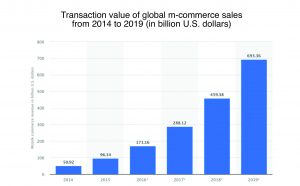Today almost every one of customers knows how to save time & money via online shopping. They compare prices, look for special offers, review product info, look for the best shipping terms. They want to get the same service online as offline and want to be fully satisfied. Retailers have to take care of their customers and offer them something special, encouraging them to buy, return and share positive feedback. Look below for 5 eCommerce trends 2020. They will help you to meet customer needs, increase loyalty and become more client-oriented.
The force of the Omnichannel approach
The main principle of the omnichannel approach is to provide an ability to switch between different channels: laptop, mobile phone, social media, online & offline stores. And in this way customer has to remain equally involved, satisfied and with the same positive experience.
Businesses that adopt omnichannel strategies achieve 91% greater year-over-year customer retention rates compared to businesses that don’t (Aspect Software). Companies with extremely strong omnichannel customer engagement see a 9.5% year-over-year increase in annual revenue, compared to 3.4% for weak omnichannel companies (Aberdeen Group).
Also, this approach is the way to fill the gaps in data analytics about customers’ behavior and their shopping insights. Using this strategy, collecting & analyzing info gives an ability to create the most personalized proposals for customers.
How great M-commerce is!
61.62% of people own mobile phones today and 43% of them make purchases online. In 2017 online-shopping via mobile phones took 4th place in the list of most popular mobile internet activities (Statista) and this trend is on the rise.
Volumes of sales in the M-commerce make up $693.36 bln in 2019 compared with $459.38 bln in 2018.

By 2021, shopping via mobile phones will be ahead of non-mobile commerce (Statista). These figures can not be ignored, therefore companies should pay due attention to the way how their users make purchases through their mobile devices and improve such moments:
- Mobile UX Design – all smartphone screens must be adopted and satisfy users’ expectations. There is no place for the nonoptimized view, buttons size, and inconvenient search bar.
- Personal information security – be sure that you can provide the right security considerations because it determines the level of customers’ trust.
- Product searches should be relevant and meet user needs. Customers expect to receive quality content, product images. They also pay attention to the availability of a product overview on a mobile site.
Want to get customers’ personal data?
For decades, users have been sharing their personal data with sellers, and now they are ready to do it even more willingly in exchange for special offers and loyalty programs. 83% percent of consumers are willing to share their data to enable a personalized experience as long as businesses are transparent about how they are going to use it and that customers have control over it.
Fast & Free. It’s all about shipping
Customers want to get their parcels fast & free, in other words – now & here. If a client hears: “Your parcel will come in two weeks”, you lose him forever and irrevocably. 39% of clients expecting two-day shipping to be free, and 29% have backed out of a purchase because two-day shipping wasn’t free.
Many consumers now consider shipping costs even before getting to the checkout page, with 65% saying they look up free-shipping thresholds before adding items to their online shopping carts (NRF).
Fast & free shipping will be an option for every merchant.
Artificial Intelligence is on the stage
More and more retailers are increasing their budgets for the implementation of AI tools in order to offer users more personalized services (Business Wire).
Researchers note that retailers now have to invest in these tools, because of the ability to understand and predict consumer demand and plan more accurate product & price policy. These instruments range from automated marketing platforms that generate tailored, timely offers, to chatbots that provide instant customer service.
Technology development & consumer behavior change so rapidly. You need to keep an eye out for these eCommerce trends in 2020. Choose and adapt eCommerce trend that suits your strategy. Do it with the aim of improving the shopping experience for your customers, and building a long-lasting relationship with them. Take your eCommerce evolution to the next level!
 Click Here to Check Out eCommerce Trends for 2021
Click Here to Check Out eCommerce Trends for 2021
Informative Post!
Indeed! A great post on the new trends that are likely to emerge in the fields of on e-commerce.
Nicely explain e-commerce trends 2020. Each end every part very informative. I glad to read your article. Thank you for sharing.
Thanks for sharing your thoughts about e-commerce trends 2020. I reckon artificial Intelligence will be booming.
Great article, truly loved it😍